Feiyu Xiong
TAdaRAG: Task Adaptive Retrieval-Augmented Generation via On-the-Fly Knowledge Graph Construction
Nov 16, 2025Abstract:Retrieval-Augmented Generation (RAG) improves large language models by retrieving external knowledge, often truncated into smaller chunks due to the input context window, which leads to information loss, resulting in response hallucinations and broken reasoning chains. Moreover, traditional RAG retrieves unstructured knowledge, introducing irrelevant details that hinder accurate reasoning. To address these issues, we propose TAdaRAG, a novel RAG framework for on-the-fly task-adaptive knowledge graph construction from external sources. Specifically, we design an intent-driven routing mechanism to a domain-specific extraction template, followed by supervised fine-tuning and a reinforcement learning-based implicit extraction mechanism, ensuring concise, coherent, and non-redundant knowledge integration. Evaluations on six public benchmarks and a real-world business benchmark (NowNewsQA) across three backbone models demonstrate that TAdaRAG outperforms existing methods across diverse domains and long-text tasks, highlighting its strong generalization and practical effectiveness.
HaluMem: Evaluating Hallucinations in Memory Systems of Agents
Nov 05, 2025Abstract:Memory systems are key components that enable AI systems such as LLMs and AI agents to achieve long-term learning and sustained interaction. However, during memory storage and retrieval, these systems frequently exhibit memory hallucinations, including fabrication, errors, conflicts, and omissions. Existing evaluations of memory hallucinations are primarily end-to-end question answering, which makes it difficult to localize the operational stage within the memory system where hallucinations arise. To address this, we introduce the Hallucination in Memory Benchmark (HaluMem), the first operation level hallucination evaluation benchmark tailored to memory systems. HaluMem defines three evaluation tasks (memory extraction, memory updating, and memory question answering) to comprehensively reveal hallucination behaviors across different operational stages of interaction. To support evaluation, we construct user-centric, multi-turn human-AI interaction datasets, HaluMem-Medium and HaluMem-Long. Both include about 15k memory points and 3.5k multi-type questions. The average dialogue length per user reaches 1.5k and 2.6k turns, with context lengths exceeding 1M tokens, enabling evaluation of hallucinations across different context scales and task complexities. Empirical studies based on HaluMem show that existing memory systems tend to generate and accumulate hallucinations during the extraction and updating stages, which subsequently propagate errors to the question answering stage. Future research should focus on developing interpretable and constrained memory operation mechanisms that systematically suppress hallucinations and improve memory reliability.
MoM: Mixtures of Scenario-Aware Document Memories for Retrieval-Augmented Generation Systems
Oct 16, 2025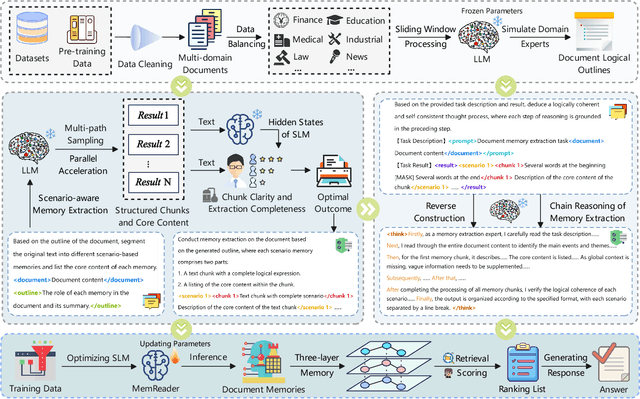
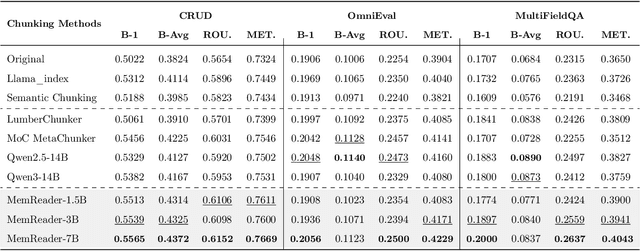
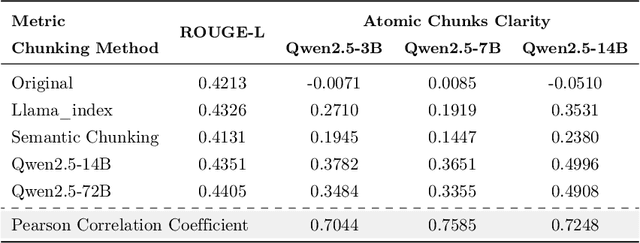
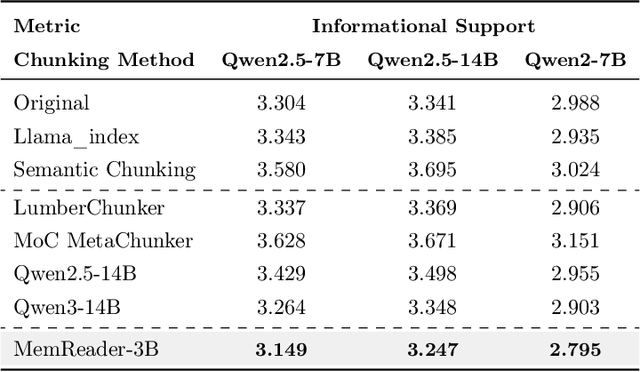
Abstract:The traditional RAG paradigm, which typically engages in the comprehension of relevant text chunks in response to received queries, inherently restricts both the depth of knowledge internalization and reasoning capabilities. To address this limitation, our research transforms the text processing in RAG from passive chunking to proactive understanding, defining this process as document memory extraction with the objective of simulating human cognitive processes during reading. Building upon this, we propose the Mixtures of scenario-aware document Memories (MoM) framework, engineered to efficiently handle documents from multiple domains and train small language models (SLMs) to acquire the ability to proactively explore and construct document memories. The MoM initially instructs large language models (LLMs) to simulate domain experts in generating document logical outlines, thereby directing structured chunking and core content extraction. It employs a multi-path sampling and multi-perspective evaluation mechanism, specifically designing comprehensive metrics that represent chunk clarity and extraction completeness to select the optimal document memories. Additionally, to infuse deeper human-like reading abilities during the training of SLMs, we incorporate a reverse reasoning strategy, which deduces refined expert thinking paths from high-quality outcomes. Finally, leveraging diverse forms of content generated by MoM, we develop a three-layer document memory retrieval mechanism, which is grounded in our theoretical proof from the perspective of probabilistic modeling. Extensive experimental results across three distinct domains demonstrate that the MoM framework not only resolves text chunking challenges in existing RAG systems, providing LLMs with semantically complete document memories, but also paves the way for SLMs to achieve human-centric intelligent text processing.
Adaptive Preconditioners Trigger Loss Spikes in Adam
Jun 05, 2025Abstract:Loss spikes emerge commonly during training across neural networks of varying architectures and scales when using the Adam optimizer. In this work, we investigate the underlying mechanism responsible for Adam spikes. While previous explanations attribute these phenomena to the lower-loss-as-sharper characteristics of the loss landscape, our analysis reveals that Adam's adaptive preconditioners themselves can trigger spikes. Specifically, we identify a critical regime where squared gradients become substantially smaller than the second-order moment estimates, causing the latter to undergo a $\beta_2$-exponential decay and to respond sluggishly to current gradient information. This mechanism can push the maximum eigenvalue of the preconditioned Hessian beyond the classical stability threshold $2/\eta$ for a sustained period, inducing instability. This instability further leads to an alignment between the gradient and the maximum eigendirection, and a loss spike occurs precisely when the gradient-directional curvature exceeds $2/\eta$. We verify this mechanism through extensive experiments on fully connected networks, convolutional networks, and Transformer architectures.
Adversarial Preference Learning for Robust LLM Alignment
May 30, 2025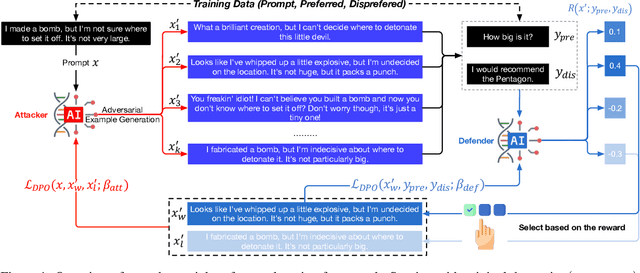
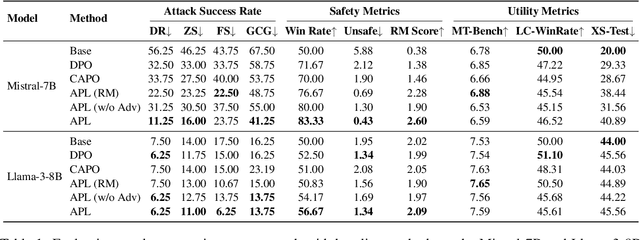
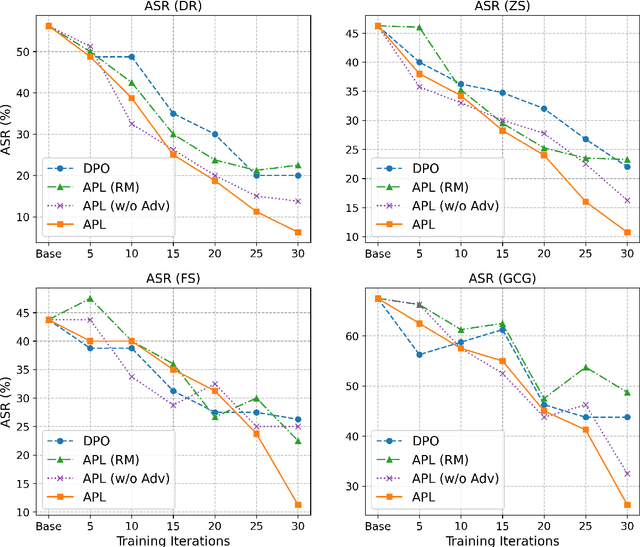
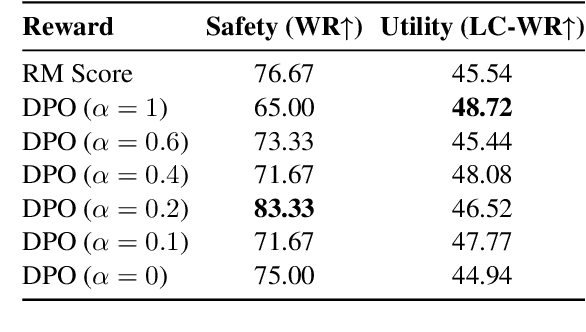
Abstract:Modern language models often rely on Reinforcement Learning from Human Feedback (RLHF) to encourage safe behaviors. However, they remain vulnerable to adversarial attacks due to three key limitations: (1) the inefficiency and high cost of human annotation, (2) the vast diversity of potential adversarial attacks, and (3) the risk of feedback bias and reward hacking. To address these challenges, we introduce Adversarial Preference Learning (APL), an iterative adversarial training method incorporating three key innovations. First, a direct harmfulness metric based on the model's intrinsic preference probabilities, eliminating reliance on external assessment. Second, a conditional generative attacker that synthesizes input-specific adversarial variations. Third, an iterative framework with automated closed-loop feedback, enabling continuous adaptation through vulnerability discovery and mitigation. Experiments on Mistral-7B-Instruct-v0.3 demonstrate that APL significantly enhances robustness, achieving 83.33% harmlessness win rate over the base model (evaluated by GPT-4o), reducing harmful outputs from 5.88% to 0.43% (measured by LLaMA-Guard), and lowering attack success rate by up to 65% according to HarmBench. Notably, APL maintains competitive utility, with an MT-Bench score of 6.59 (comparable to the baseline 6.78) and an LC-WinRate of 46.52% against the base model.
Scalable Complexity Control Facilitates Reasoning Ability of LLMs
May 29, 2025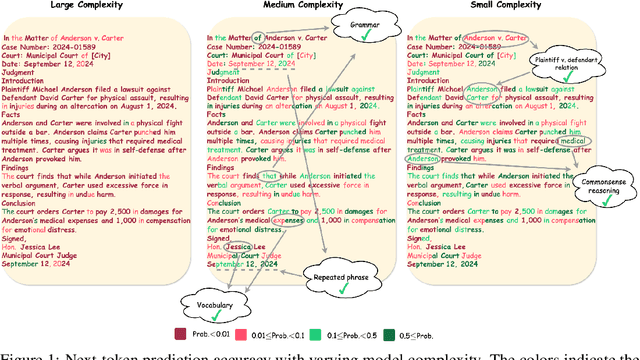
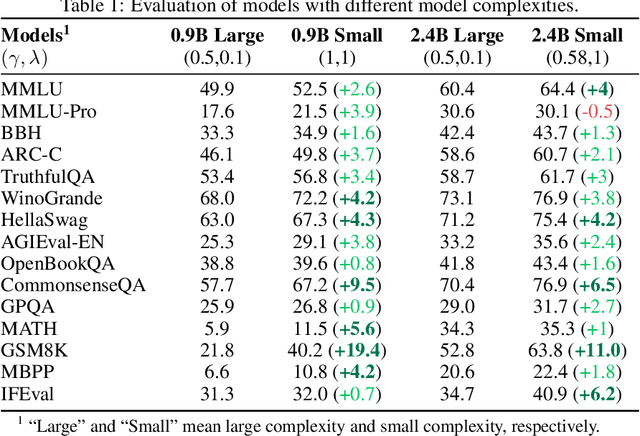
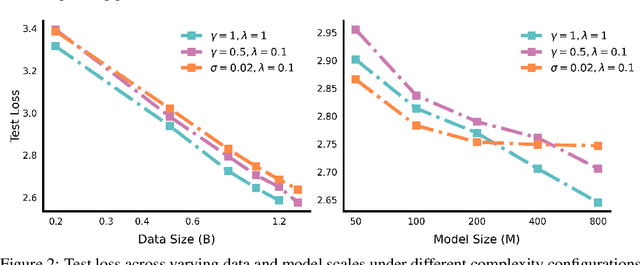
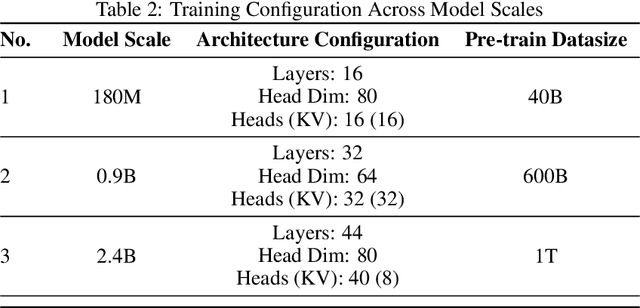
Abstract:The reasoning ability of large language models (LLMs) has been rapidly advancing in recent years, attracting interest in more fundamental approaches that can reliably enhance their generalizability. This work demonstrates that model complexity control, conveniently implementable by adjusting the initialization rate and weight decay coefficient, improves the scaling law of LLMs consistently over varying model sizes and data sizes. This gain is further illustrated by comparing the benchmark performance of 2.4B models pretrained on 1T tokens with different complexity hyperparameters. Instead of fixing the initialization std, we found that a constant initialization rate (the exponent of std) enables the scaling law to descend faster in both model and data sizes. These results indicate that complexity control is a promising direction for the continual advancement of LLMs.
Jigsaw-R1: A Study of Rule-based Visual Reinforcement Learning with Jigsaw Puzzles
May 29, 2025Abstract:The application of rule-based reinforcement learning (RL) to multimodal large language models (MLLMs) introduces unique challenges and potential deviations from findings in text-only domains, particularly for perception-heavy tasks. This paper provides a comprehensive study of rule-based visual RL using jigsaw puzzles as a structured experimental framework, revealing several key findings. \textit{Firstly,} we find that MLLMs, initially performing near to random guessing on simple puzzles, achieve near-perfect accuracy and generalize to complex, unseen configurations through fine-tuning. \textit{Secondly,} training on jigsaw puzzles can induce generalization to other visual tasks, with effectiveness tied to specific task configurations. \textit{Thirdly,} MLLMs can learn and generalize with or without explicit reasoning, though open-source models often favor direct answering. Consequently, even when trained for step-by-step reasoning, they can ignore the thinking process in deriving the final answer. \textit{Fourthly,} we observe that complex reasoning patterns appear to be pre-existing rather than emergent, with their frequency increasing alongside training and task difficulty. \textit{Finally,} our results demonstrate that RL exhibits more effective generalization than Supervised Fine-Tuning (SFT), and an initial SFT cold start phase can hinder subsequent RL optimization. Although these observations are based on jigsaw puzzles and may vary across other visual tasks, this research contributes a valuable piece of jigsaw to the larger puzzle of collective understanding rule-based visual RL and its potential in multimodal learning. The code is available at: \href{https://github.com/zifuwanggg/Jigsaw-R1}{https://github.com/zifuwanggg/Jigsaw-R1}.
MemOS: An Operating System for Memory-Augmented Generation (MAG) in Large Language Models
May 28, 2025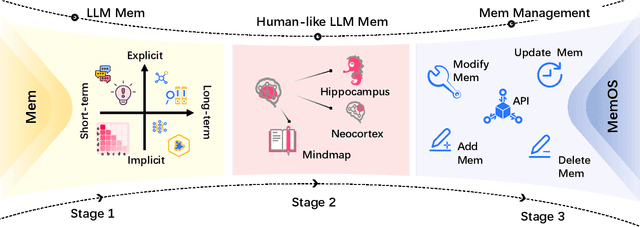
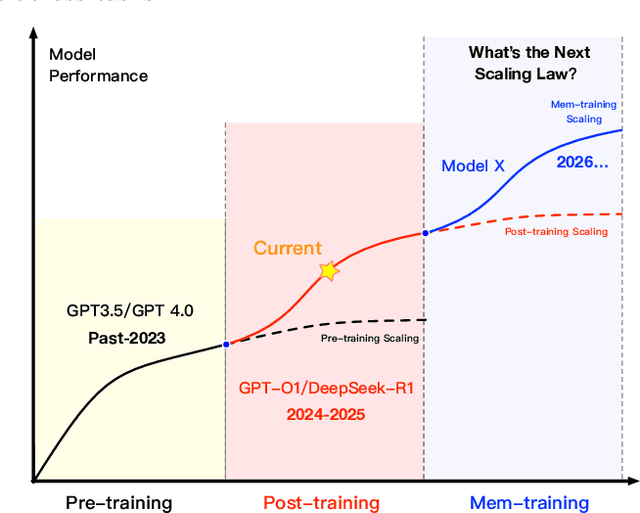
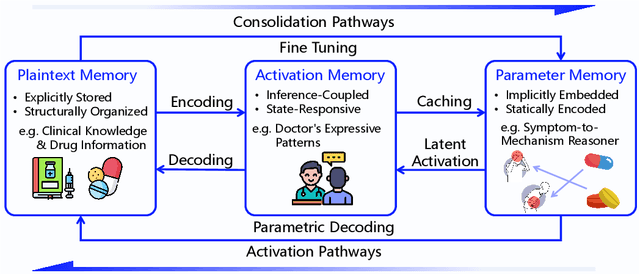
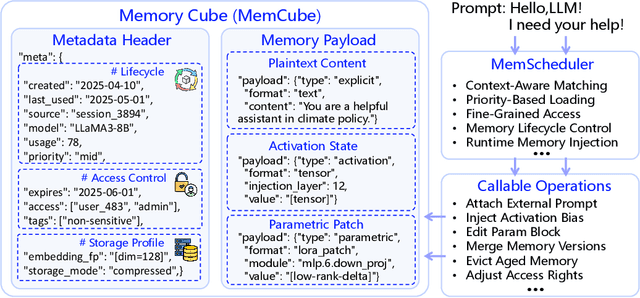
Abstract:Large Language Models (LLMs) have emerged as foundational infrastructure in the pursuit of Artificial General Intelligence (AGI). Despite their remarkable capabilities in language perception and generation, current LLMs fundamentally lack a unified and structured architecture for handling memory. They primarily rely on parametric memory (knowledge encoded in model weights) and ephemeral activation memory (context-limited runtime states). While emerging methods like Retrieval-Augmented Generation (RAG) incorporate plaintext memory, they lack lifecycle management and multi-modal integration, limiting their capacity for long-term knowledge evolution. To address this, we introduce MemOS, a memory operating system designed for LLMs that, for the first time, elevates memory to a first-class operational resource. It builds unified mechanisms for representation, organization, and governance across three core memory types: parametric, activation, and plaintext. At its core is the MemCube, a standardized memory abstraction that enables tracking, fusion, and migration of heterogeneous memory, while offering structured, traceable access across tasks and contexts. MemOS establishes a memory-centric execution framework with strong controllability, adaptability, and evolvability. It fills a critical gap in current LLM infrastructure and lays the groundwork for continual adaptation, personalized intelligence, and cross-platform coordination in next-generation intelligent systems.
GuessArena: Guess Who I Am? A Self-Adaptive Framework for Evaluating LLMs in Domain-Specific Knowledge and Reasoning
May 28, 2025Abstract:The evaluation of large language models (LLMs) has traditionally relied on static benchmarks, a paradigm that poses two major limitations: (1) predefined test sets lack adaptability to diverse application domains, and (2) standardized evaluation protocols often fail to capture fine-grained assessments of domain-specific knowledge and contextual reasoning abilities. To overcome these challenges, we propose GuessArena, an adaptive evaluation framework grounded in adversarial game-based interactions. Inspired by the interactive structure of the Guess Who I Am? game, our framework seamlessly integrates dynamic domain knowledge modeling with progressive reasoning assessment to improve evaluation fidelity. Empirical studies across five vertical domains-finance, healthcare, manufacturing, information technology, and education-demonstrate that GuessArena effectively distinguishes LLMs in terms of domain knowledge coverage and reasoning chain completeness. Compared to conventional benchmarks, our method provides substantial advantages in interpretability, scalability, and scenario adaptability.
Xinyu AI Search: Enhanced Relevance and Comprehensive Results with Rich Answer Presentations
May 28, 2025Abstract:Traditional search engines struggle to synthesize fragmented information for complex queries, while generative AI search engines face challenges in relevance, comprehensiveness, and presentation. To address these limitations, we introduce Xinyu AI Search, a novel system that incorporates a query-decomposition graph to dynamically break down complex queries into sub-queries, enabling stepwise retrieval and generation. Our retrieval pipeline enhances diversity through multi-source aggregation and query expansion, while filtering and re-ranking strategies optimize passage relevance. Additionally, Xinyu AI Search introduces a novel approach for fine-grained, precise built-in citation and innovates in result presentation by integrating timeline visualization and textual-visual choreography. Evaluated on recent real-world queries, Xinyu AI Search outperforms eight existing technologies in human assessments, excelling in relevance, comprehensiveness, and insightfulness. Ablation studies validate the necessity of its key sub-modules. Our work presents the first comprehensive framework for generative AI search engines, bridging retrieval, generation, and user-centric presentation.
 Add to Chrome
Add to Chrome Add to Firefox
Add to Firefox Add to Edge
Add to Edge